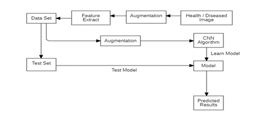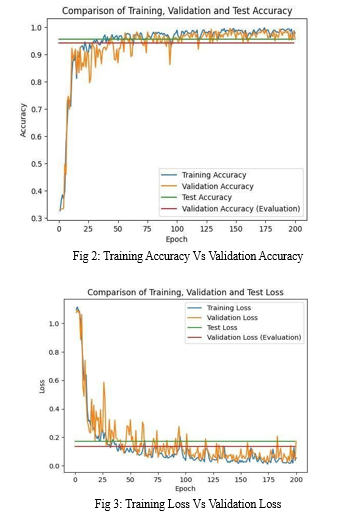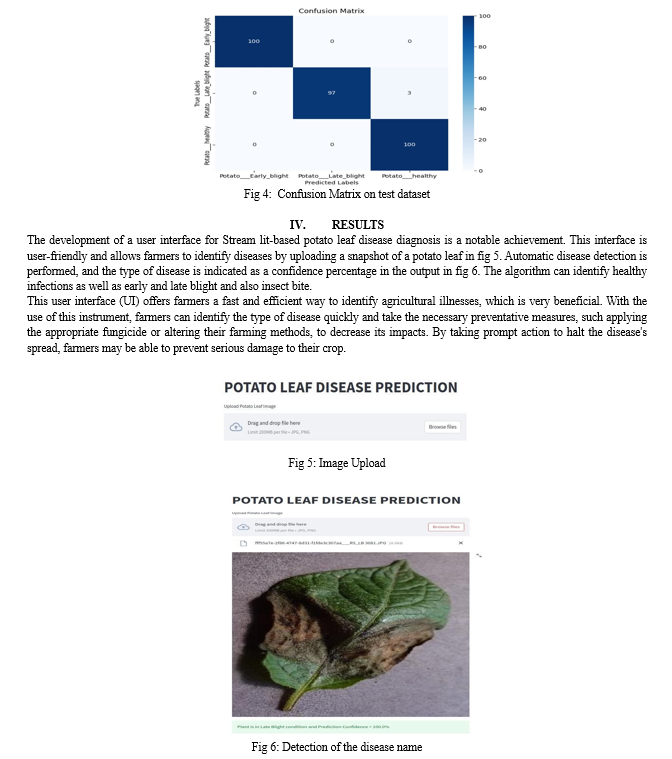Ijraset Journal For Research in Applied Science and Engineering Technology
- Home / Ijraset
- On This Page
- Abstract
- Introduction
- Conclusion
- References
- Copyright
Potato Leaf Disease Classification using Deep Learning Technique CNN
Authors: Reshni S, Anjaneyulu Konakanchi, Naveen Kumar Dhulipalla, Manikanta Neelam
DOI Link: https://doi.org/10.22214/ijraset.2024.58538
Certificate: View Certificate
Abstract
In this work, we suggest a unique method that makes use of convolutional neural networks (CNN) to identify potato leaf disease. Our approach makes use of deep learning to precisely identify and categorise a range of illnesses that impact potato leaves. We achieve great levels of accuracy and robustness in disease identification by training the CNN model on a large dataset of healthy and diseased potato leaves. Farmers and agronomists may identify and control illnesses more quickly and automatically with the help of this suggested technique, which will increase crop output and production. Our technique has shown encouraging results through thorough experimentation and validation, indicating its potential for real-world use in agricultural contexts.
Introduction
I. INTRODUCTION
Potato cultivation provides a staple crop for millions of people globally, making it an important contributor to global food security. However, a number of issues, notably the frequency of plant diseases, make it extremely difficult for the agricultural sector to sustain adequate potato production. Leaf infections are one type of illness that can seriously harm crop health and yield. Sustainable agriculture and effective disease management depend on early detection and prompt intervention. Plant disease identification with traditional approaches frequently depends on the subjective and time-consuming visual inspections of experts. A growing number of people are interested in using artificial intelligence—more especially, deep learning techniques—to improve the effectiveness and precision of agricultural disease diagnosis as technology advances. The automated detection of potato leaf diseases is the main emphasis of this research, which uses Convolutional Neural Networks (CNNs), a subtype of deep learning techniques. CNNs are an excellent option for recognising patterns and characteristics within complicated visual data, such as photos of plant leaves, because they are especially well-suited for image analysis tasks. The aim of this research is twofold: firstly, to create a reliable CNN-based model that can correctly identify illnesses of potato leaves, and secondly, to investigate how deep learning could transform precision agriculture. In addition to assisting with early diagnosis, the application of cutting-edge technology in disease detection enables focused and effective interventions that reduce the need for pesticides and support sustainable farming methods. The research is expected to produce a cutting-edge CNN model for detecting potato leaf disease, providing farmers and agronomists with a dependable and effective remedy. Deep learning in agriculture has the ability to transform crop management and open the door to a precision farming industry that is more technologically advanced and sustainable in the future.
II. LITERATURE SURVEY
The process for identifying plant diseases in smart farming through the use of a deep learning algorithm was methodically described in the Guo et al. (2020) paper. The writers started by gathering a wide range of plant photos that included images of different illnesses. They then used a deep learning technique to develop a model that could correctly identify and classify plant illnesses based on attributes seen in images. To improve the model's performance, optimisation techniques were used during the training process. To verify the model's generalizability and robustness, cross-validation techniques were used. The authors have integrated smart farming technologies to enable the prompt diagnosis of diseases in agricultural environments. The methodology presents a complete strategy for effective disease management that integrates cutting-edge machine learning techniques with real-world agricultural applications.
Goyal, L. M., Saeed, F., Khan, M. A., Sharif, M., Mittal, M., & Roy, S. (2021). A deep neural network application for the classification of crop diseases uses feature fusion and selection based on PLS regression. In that paper, they suggested an automated system for identifying agricultural diseases by selecting features from an extracted deep feature set using partial least squares (PLS) regression.
The framework that is being described consists of three main stages: A pre-trained Visual Geometry Group (VGG19) convolutional neural network (CNN) model is used to extract the deep features first; the features extracted from fully connected layers 6 and 7 are combined using a PLS-based parallel fusion method.
A multi-step procedure was used by Iqbal and Talukder (2020) to detect potato illnesses. First, a dataset with a variety of potato photos was gathered. Image segmentation techniques were then used to identify and isolate the impacted areas from the rest of the potato photos. To extract pertinent characteristics from the segmented regions, feature extraction was done. The retrieved features were then used to train machine learning algorithms, such as convolutional neural networks or support vector machines, to categorise the potato disorders. Accuracy, precision, and recall were among the criteria used to assess the model's performance. A cross-validation strategy was used to guarantee robustness, and the entire methodology was put into practice utilising widely used image processing.
In the research they conducted titled "Recognition of early blight and late blight diseases on potato leaves based on CNN algorithm," A Convolutional Neural Network (CNN) method was used by Koshariya, A. K., Priyadharshini, B., Ramalakshmi, V., Pradhan, K., and Balamuralitharan, S. (2022) to identify early and late blight illnesses on potato leaves. Gathering a dataset of photos of potato leaves afflicted by these illnesses was part of the research. After applying pre-processing techniques to improve image quality, the dataset was split into training and testing sets. The training set was then used to train the CNN algorithm to distinguish between patterns linked to early and late blight. The testing set's performance was evaluated in order to determine how accurate the algorithm was at identifying diseases. The goal of the project was to use cutting-edge machine learning techniques to develop an automated disease detection system for potato crops that is both accurate and efficient.
III. PROPOSED METHODOLOGY
The concept of convolutional neural networks (CNNs) is explained in the article, along with how to apply them to picture classification in order to identify leaf illnesses in photos. CNNs are a type of feedforward neural network that can process multidimensional input; they are composed of layers of perceptron’s. The paper outlines the procedures for implementing a CNN model for leaf disease detection. These consist of gathering input images of leaves, preprocessing and organising them into arrays, sorting and organising the leaf image database, training the model with CNN classification methods, contrasting the Pre-processed test image with the trained model, and, in the event that a leaf defect region is discovered, presenting the disease and its remedy.
The number and size of filters in the convolutional layer can affect how well the CNN model performs. Experimenting with different configurations can improve the model's performance, which can also be impacted by the activation function selection. CNNs frequently employ the activation functions tanh, sigmoid, and ReLU.
A. Image Acquisition
The first step in image processing is gathering a large enough dataset. This particular model was built using the Plant Village Dataset, which is available on Kaggle and comprises 6643 carefully
identified pictures of leaves with superb quality and angles. To increase accuracy, all sick leaves of the same type were gathered into one folder. Since there was no data in the dataset, it needed to be cleaned up and tagged. The collection includes images of both healthy and diseased leaves categorised into three labels, as seen in Figure 1. From the photos, three sets of data were generated: train, validation, and test. The dataset is unique to the potato plant and contains information on the leaf illnesses that are linked to it, how many images are included in each folder of the Plant Village Dataset for each disease, and the traits of each disease, which are detailed in TABLE
|
PLANT |
DISEASE NAME |
NO. OF IMAGES |
FEATURES |
|
Potato |
Healthy |
1045 |
No Spots |
|
Potato |
Late blight |
1000 |
Brown patches |
|
Potato |
Early Blight |
1000 |
Yellow Patches |
Table 1: Potato Leaf Disease Dataset Details
B. Pre-Processing
An essential step in the categorization of images is preprocessing, which covers techniques like image scaling, data augmentation, normalisation, and more. Using the image size option, the images were reduced in size to 256x256 pixels in order to preserve consistency in the picture dimensions throughout the model building process. This is an important step because it allows the model to correctly interpret the features and patterns in the pictures. This is essential to prevent overfitting of the model and ensure proper model generalisation to new data. The training data was further pre-processed using data augmentation techniques, such as random flips, rotations, scaling, and resizing. The data augmentation technique can be used to artificially increase the size of the training set by randomly altering the preexisting photographs.

This is carried out to enhance the model and prevent overfitting. To help the model understand how different lighting, angles, and other factors affect the photographs, common data augmentation techniques include random flips, rotations, zooming, and resizing.
The addition of data the images were scaled to values between 0 and 1 using the rescaling layer of the sequential model. At this point, the data needs to be scaled consistently and normalised. Normalisation accelerates the convergence process during training and improves the model's performance and accuracy.
All things considered, these preprocessing procedures enhance accuracy and performance by training the model on high-quality and diverse data. The data is pre-processed before being ready to be entered into the model for feature extraction, statistical analysis, classifier classification, and finally, results retrieval.
C. Image Augmentation
Generating new training data from preexisting data is a technique known as data augmentation. In this approach, the data augmentation was performed using the multi-layer picture augmentation Kera’s Sequential model. To improve the data, layers like Random Flip, Random Rotation, Random Zoom, Random Height, and Random Width are used The Random Flip layer randomly flips the input image, either vertically or horizontally, to help the model acquire features regardless of the orientation of the image. The purpose of the Random Rotation layer is to randomly rotate the image so that the model can learn from different perspectives. The Random Zoom layer can help the model learn features at different scales by arbitrarily changing the zoom level of the picture. The Random Height and Random Width layers, which randomly change the image's height and width, allow the model to learn from images with different aspect ratios.
The images were rescaled using the Rescaling layer to ensure that the pixel values are between 0 and 1. This can help the model train by maintaining consistency in the pixel values across all the photographs. The augmented photographs are then used to train the model, increasing accuracy and efficiency.
D. Feature Extraction
Features are extracted using the architecture of a convolutional neural network (CNN). In particular, the model consists of several convolutional layers with varying numbers, sizes, and filter activation functions. In order to reduce the spatial dimensionality of the input data and down sample the feature maps, max-pooling layers are added after the convolutional layers.
E. Statistical Analysis
The trained model is assessed on the validation dataset prior to testing it on the testing dataset. Three outcomes could arise from this analysis. If the accuracy decreases and the loss increases, the model is overfitting and not learning. If the loss grows as the accuracy increases and SoftMax is used in the output layer, the model can be overfitting or have a range of probability values. If, however, the accuracy increases and the loss decreases, the model is truly learning.
To optimise network weights, we used the Adams optimisation algorithm with a learning rate of 0.05 and a categorical cross-entropy loss metric. Our model takes one to two minutes per epoch to train under the conditions of our experiment. We created a classification report on the test dataset using Sklearn. As shown in Figs. 2 and 3, we used matplotlib to plot the training vs. validation accuracy and loss in order to assess the trends in accuracy and loss. The decreasing trend in loss and increasing trend in accuracy show how well the deployed model is adjusting and operating. The network weights with the lowest validation loss at the 100th epoch was chosen for testing.


V. FUTURE SCOPE
Our goal is to create a smartphone application in the future that will forecast potato leaf diseases, making this vital technology even more accessible to farmers across the globe. Even the least tech-savvy customers will be able to easily navigate and utilise the smartphone application thanks to its user-friendly layout. Through the programme, farmers will be able to conveniently evaluate the health of their potato crops right from their mobile devices, taking advantage of the widespread adoption of smartphones.
Our goal is to transform farmers' approaches to disease management in potato crops by establishing a link between cutting-edge technology and traditional farming methods via an intuitive smartphone application. This project has the potential to greatly increase agricultural yields, support sustainable farming methods, and eventually improve global food security through broad acceptance and ongoing improvement.
Conclusion
To assist farmers, the main goal is to accurately detect and diagnose diseases that impact the leaves of potato plants. Using neural networks, a model is created to simulate how the human brain functions, which is different from earlier constrained methods. With the use of a CNN architecture, this model is able to detect potato leaf illnesses with an astonishing 99% accuracy rate. It also has the potential to be faster and more precise by utilizing GPU utilization. This approach gets around the problem of needing expensive subject knowledge. The model suggests the best methods for prompt restoration of plant health after accurate disease detection. Furthermore, the mobile application prioritizes accessibility by including offline capability, which lessens the need for internet connectivity in rural farming regions where network infrastructure may be weak. This offline feature makes sure farmers can use the app wherever they are, which increases its usefulness and practicality.
References
[1] Guo, Y., Zhang, J., Yin, C., Hu, X., Zou, Y., Xue, Z., & Wang, W. (2020). Plant disease identification based on deep learning algorithm in smart farming. Discrete Dynamics in Nature and Society, 2020, 1-11. [2] Saeed, F., Khan, M. A., Sharif, M., Mittal, M., Goyal, L. M., & Roy, S. (2021). Deep neural network features fusion and selection based on PLS regression with an application for crops diseases classification. Applied Soft Computing, 103, 107164. [3] Iqbal, M. A., & Talukder, K. H. (2020, August). Detection of potato disease using image segmentation and machine learning. In 2020 international conference on wireless communications signal processing and networking (WiSPNET) (pp. 43-47). IEEE. [4] Koshariya, A. K., Priyadharshini, B., Ramalakshmi, V., Pradhan, K., & Balamuralitharan, S. (2022). Recognition of early blight and late blight diseases on potato leaves based on CNN algorithm. NeuroQuantology, 20(7), 2711. [5] Hou, C., Zhuang, J., Tang, Y., He, Y., Miao, A., Huang, H., & Luo, S. (2021). Recognition of early blight and late blight diseases on potato leaves based on graph cut segmentation. Journal of Agriculture and Food Research, 5, 100154. [6] Lamba, M., Gigras, Y., & Dhull, A. (2021). Classification of plant diseases using machine and deep learning. Open Computer Science, 11(1), 491-508. [7] Islam, M., Dinh, A., Wahid, K., & Bhowmik, P. (2017, April). Detection of potato diseases using image segmentation and multiclass support vector machine. In 2017 IEEE 30th canadian conference on electrical and computer engineering (CCECE) (pp. 1-4). IEEE. [8] Lee, T. Y., Lin, I. A., Yu, J. Y., Yang, J. M., & Chang, Y. C. (2021). High efficiency disease detection for potato leaf with convolutional neural network. SN Computer Science, 2(4), 297. [9] Tugrul, B., Elfatimi, E., & Eryigit, R. (2022). Convolutional neural networks in detection of plant leaf diseases: A review. Agriculture, 12(8), 1192. [10] Zhang, Y., Song, C., & Zhang, D. (2020). Deep learning-based object detection improvement for tomato disease. IEEE access, 8, 56607-56614. [11] Krishnakumar, B., Kousalya, K., Prakash, K. I., Ida, S. J., Ravichandra, B., & Rajeshkumar, G. (2023, March). Comparative Analysis of Various Models for Potato Leaf Disease Classification using Deep Learning. In 2023 Second International Conference on Electronics and Renewable Systems (ICEARS) (pp. 1186-1193). IEEE. [12] Nishad, M. A. R., Mitu, M. A., & Jahan, N. (2022). Predicting and Classifying Potato Leaf Disease using K-means Segmentation Techniques and Deep Learning Networks. Procedia Computer Science, 212, 220-229. [13] Singh, A., & Kaur, H. (2021). Potato plant leaves disease detection and classification using machine learning methodologies. In IOP Conference Series: Materials Science and Engineering (Vol. 1022, No. 1, p. 012121). IOP Publishing. [14] Tiwari, D., Ashish, M., Gangwar, N., Sharma, A., Patel, S., & Bhardwaj, S. (2020, May). Potato leaf diseases detection using deep learning. In 2020 4th international conference on intelligent computing and control systems (ICICCS) (pp. 461-466). IEEE. [15] Mahum, R., Munir, H., Mughal, Z. U. N., Awais, M., Sher Khan, F., Saqlain, M., ... & Tlili, I. (2023). A novel framework for potato leaf disease detection using an efficient deep learning model. Human and Ecological Risk Assessment: An International Journal, 29(2), 303-326.
Copyright
Copyright © 2024 Reshni S, Anjaneyulu Konakanchi, Naveen Kumar Dhulipalla, Manikanta Neelam. This is an open access article distributed under the Creative Commons Attribution License, which permits unrestricted use, distribution, and reproduction in any medium, provided the original work is properly cited.

Download Paper
Paper Id : IJRASET58538
Publish Date : 2024-02-21
ISSN : 2321-9653
Publisher Name : IJRASET
DOI Link : Click Here
 Submit Paper Online
Submit Paper Online

